Kill Screen Magazine's Blog, page 214
October 8, 2015
All cyberpunk heads to Hong Kong eventually. Shadowrun does it right
Shadowrun Hong Kong’s Asian dystopia is no science fiction
Explore a portrait of a game creator in The Beginner's Guide
Sign up to receive each week's Playlist e-mail here!
Also check out our full, interactive Playlist section.
The Beginner's Guide (PC, Mac)
BY Everything Unlimited LTD
The Beginner's Guide, a followup from the creator of The Stanley Parable (which is a game about games) is a videogame about the people that make them. Somewhere amidst all that game-ness is the portrait of a person, a friendship, and a community of people who are still figuring out how to create and even talk about this thing they love. Voiced by the designer himself, Davey Wreden, Beginner's Guide sets you out on a journey to understand Davey's friend, Coda, through a series of interactive art Coda made between 2008 and 2011. At the center of every game within this game is a simultaneous sense of being part of a larger conversation and a resounding loneliness. By sifting through Coda's messy pile of unfinished ideas and concepts abstracted beyond recognition, Davey reveals the beautiful chaos of creation. And perhaps something more.
Perfect for: Existential types, game makers, creators
Playtime: An hour
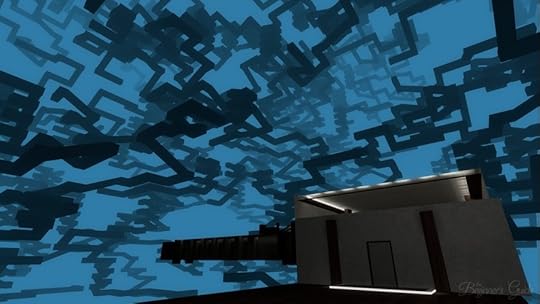
Let���s talk about the ending of The Beginner���s Guide
Should Davey Wreden have released The Beginner’s Guide?
October 7, 2015
Overland turns the post-apocalyptic road trip into a series of delicate dioramas
Overland has the look of something you could feasibly prod. It comes across as a series of cartoon-coated dioramas that are made to be admired up close. This is no accident. As designer Adam Saltsman explains in a new video about Overland, by having "clear, obvious visuals composed on a single screen," what is usually an inaccessible genre—squad-based tactics in this case—is made "available to a new wider audience without sacrificing depth or challenge."
The idea is to help a group of people survive a hellish road trip across a ravaged America. The most obvious threat are the sound-sensitive beasts that scuttle with deadly purpose across the grid-based environments. But, on a larger scale, the random generation of your journey means that you can't rely on finding medkits, gasoline, weapons, or other supplies when moving forward. This uncertainty lends itself to the game's constant risk and it's why each move you make can seal the fate of one or more of your troupe.
devastating fatalism of this human-to-human drama
But this is only half of Overland, at least, according to how Saltsman describes it. In the video he details, at first, the "Encounters" on those grids. They are focused, tense, and require precise tactics to survive. As said, the visuals are the key component in making these sections exoteric. The other half of the game is referred to as "Interludes." These usually take place around a campfire where you make "higher-level strategic decisions."
That might sound imposing. But Overland's hardest decisions should be familiar if you've delved into any fiction set in the post-apocalypse. The idea is to oppose the inclinations of your heart against those of your head. "What do you do when there's only one seat left in the vehicle? Do you take a healthy passenger with no particularly useful profession? Or do you try to save the wounded specialist?" Saltsman asks.
We can all grasp the difficulty of such a situation. It's the devastating fatalism of this human-to-human drama that has made shows like The Walking Dead so popular. And so the theory goes that these tough but straight-forward choices pair with the game's visuals in making Overland more widely appealing.
Unfortunately, with this new video comes the news that Overland is still a ways off yet. It should be coming to Windows and Mac in 2016. If that's too long, then hopefully the new website that details the game will tide you over. There are also new screenshots as you can see below.
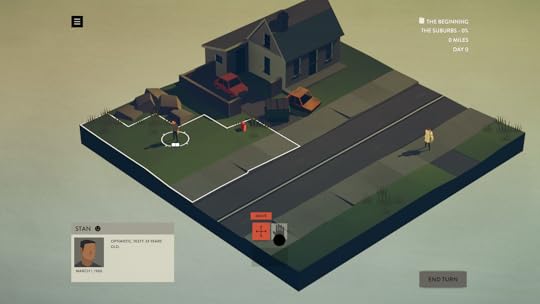

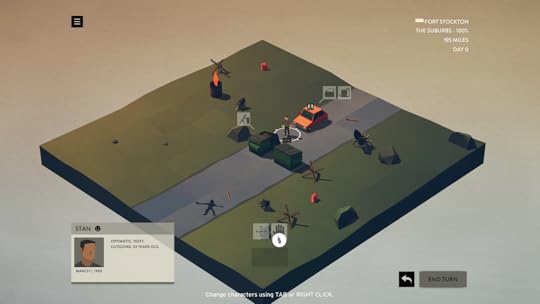

The Witch is an atavistic Puritan nightmare for the ages
We're still rounding up Fantastic Fest, bringing you impressions of our favorite films shown at the event. For all of our hot, hot takes, head over here.
///
To properly explain The Witch to you, I need to give you two pieces of context.
One: I grew up in rural Vermont. My house was sat off a dirt road winding through woods, woods I never really explored. They were just there, ever-present. Our town had a few ghost stories, born of boredom, I imagine. We even had our own cryptid, the Pigman, who lived in the woods near a particularly suspension-straining stretch of back road called "the Devil's Washbowl." The Pigman is, as far as I can recall, a naked guy with a pig's head and he runs across the road or just stands there, in the woods, watching as you pass by.
It's a fairly standard small-town spook story. But there's a reason they find such traction in sleepy rural places: when you're out on a dirt road at 2AM in the dead of winter in a car with barely any gas and your friend decides this is the best time to mention the Pigman, it gives you this thrill somewhere in your gut. Your stomach turns over. What if—somewhere, in these woods, there's something? Something ancient, something unimaginable? It's at once terrifying and exhilarating. What if high school isn't all there is? To have your bones gnawed clean by the Pigman ... well, it'd be something for people to talk about, at least.
the appearance of a waking nightmare.
Two: the first time I ever got that thrill in my gut was when I watched Night of the Living Dead as a preteen. Two scenes stick out in my mind as sites of blood-curdling horror: a pack of zombies devouring the shattered remains of two would-be survivors after their truck explodes, and a mother being stabbed to death by her zombified daughter. The scraping, atonal soundtrack, the prominent gore, and the callous brutality got to me. I wasn't ready for that shit.
I got the same feeling when I watched The Omen not long after, except there, it was compounded by years of churchgoing and catechism classes. I never believed in God or any of it, but the idea that Satan might come to earth disguised as a sallow little boy? And not with fire and many-eyed minions but with simple, direct violence he could calmly dispatch anyone in his way? It preyed upon so much inside me.

I left The Witch with tears in my eyes: partly from the exhausting, draining ordeal of watching the film, but also from joy, at finally recapturing that feeling of primal terror that led me to fall in love with horror in the first place.
The Witch bills itself as "A New England folktale," and this is crucial to appreciating what it's up to. It depicts a Puritan family cast out from their village thanks to their patriarch's pride, left to live on the edge of the woods with only God's grace and their small harvest to sustain them, and their slow descent into madness. Remember the line "Nature is Satan's church," from von Trier's Antichrist? This is along those lines.
The dialogue is all ornate, archaic speech. The music is an intensely hellish din of droning strings and wailing, wordless chants. The slightly boxy 1.66:1 cinematography is claustrophobic, lit by flickering candlelight and draped in suffocating gray gloom. The end result is that you barely understand what anyone is saying between the accents, the syntax, and the music; it has the appearance of a waking nightmare.
that sudden sick shock
When the family's infant son goes missing (in a bloodcurdlingly matter-of-fact scene), their oldest daughter comes under suspicion of witchcraft. But as the audience, we're given a glimpse of what presumably happened to him, and it is fucking horrifying. First-time (!!!) director Robert Eggers recasts familiar folkoric imagery in alien terms: a witch on a broomstick becomes a shot of the moon being gradually obscured by something looming into frame. The witch's cackle becomes a squatting, naked old woman laughing a toothless, mirthless laugh. The Satanic goat becomes a billy named Black Philip who might be constantly whispering filthy, evil ideas into two young twins' ears. The bubbling cauldron full of unholy potion becomes ... well, you should probably see that for yourself.
The film builds patiently, as it needs to. It strands you in a place where there is no help and little sanity: young boys are drilled on their inescapable original sin, the woods loom dark and thick, and any ills are the devil's work. By the time it tips its hand as to what's really going on, we've descended so far into subjective madness that any line between the metaphorical and the literal has been obliterated.
If you didn't grow up with Catholicism and tall tales, perhaps you'll find The Witch slow and stagey, and you'll think I'm just another hyperbolic internet clown who wants to crown The Best New Thing.
But The Witch moved me. It reached into me to a place past logic and cynicism to scare me on a visceral level. Several scenes have the sheer wrongness of that guy standing in the corner at the end of Blair Witch, that sudden sick shock: chief among them might be a fucking soliloquy. Yeah, this movie makes a soliloquy absolutely chilling. Whatever Robert Eggers does next will probably split the world in two.
The Beginner���s Guide to the art of videogames
Wreden on Wreden isn't perfect, but it raises questions with a clarity few games have dared.
Gaze upon the kinky, deformed face of Craigslist casual encounters
Finding yourself in the Craigslist casual encounters personal ads feels like accidentally stepping into a new world you never knew existed. It has its own language (i.e. I'm a DDF w4m who's down to be FWB, is HWP, and into sub/dom). It has its own societal norms and code of conduct (discreteness and height/weight proportionality are key to be being a productive Craigslist casual encounter citizen). Essentially, it's like you accidentally got invited to that Eyes Wide Shut orgy, only instead of creepy masks, everyone's face has been replaced by a dick pic.
everyone's face has been replaced by a dick pic
Love Letters from Craig, a piece by Cartelle Interactive Arts, opens this lurid and unsettling world of virtual sweet nothing to 18+ viewers who dare to enter the site past it's early 2000-style entry page. Inside Love Letter from Craig is a synthesized voice rendering of random Craiglist casual encounters, to the backdrop of various cascading objects such as: a severed breast, lipstick, bananas, and pills.
The voice—a sultry combination of that robot from I, Robot and whoever voices Tom Tom GPS navigation systems—captures even the dirtiest and thirstiest ads with a sense of dignity. At the very least, I know I'll never hear the words "creamy load" and "dominant man cock" delivered with such restraint.
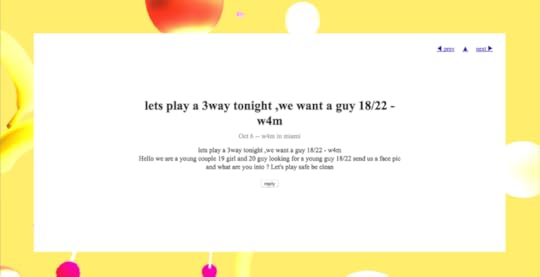
Cartelle Interactive Arts calls Love Letters from Craig "a romantic exploration into the perversions of modern-day digital hookups." To an extent, Love Letters From Craig does feel like looking into a fun house mirror of romance: a funny distortion of our collective adolescent mind, chasing fantasies and testing our limits (and genitals ). Love Letters From Craig is the logical conclusion to sex on the internet: a wasteland of pornographic loneliness—their cries for help emitting from below the belt and culminating into one, long groan of despair.
Oh, and pro tip: avoid the reply button on any Love Letters From Craig post at all costs.
The fell kings of the cul-de-sac return on Deafheaven's New Bermuda
The suburbs suck: from Rush to Arcade Fire to Deafheaven.
A videogame about sacrificing townspeople to an unseen god
The Sacrifice, made by team foxboard for a Ludum Dare is, at first glance, a difficult-to-impossible resource management game. Players direct a town comprised of five families, assigning seasonal tasks and trying to maintain enough housing, food reserves, morale, and secrecy. At the same time, players also act as executioner. At the end of each season, one townsperson must be sacrificed to maintain the graces of their god.
Morality has little to no place in your decision making.
Morality has little to no place in your decision making. A murderer may be well-liked and their death may cause more civil unrest than the death of a hard worker townspeople consider weird. While you have fewer to house and feed if people leave, with them they’ll take rumors of your sacrifices, bringing critical eyes and the demise of your town.
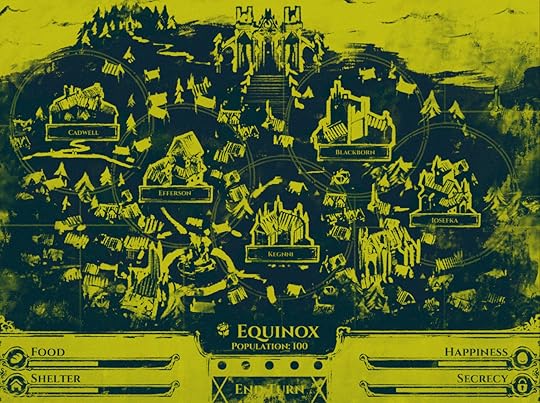
Your task in The Sacrifice is simple, but difficult: Maintain food and housing, choose who to kill to keep your town surviving, and make sure those who are left are happy despite the constant deaths. Isn't paganism wonderful?
October 6, 2015
The vast, lurid possibilities of PNG glitches
Glitch art is wonderful. It has the potential to be beautiful and horrifying. The best is often both at the same time. It's got so popular now that most of us can appreciate glitch art on a visual level. But when it comes to talking about it, well, we don't really have a clue. There isn't an established vocabulary surrounding glitch art so we're left to just say "wow" or "wtf?!" We can do better.
One person who is helping with that is Tokyo-based artist UCNV. He's delivered a document that aims to help us understand how to glitch PNGs. If you're anything like me, you've already tinkered with glitching PNGs in text editors such as Notepad or Wordpad—this is a well-known way of doing it. But UCNV refuses this procedure, saying that "it is impossible to generate glitches using simple methods" like these, adding that "you will completely fail."
noticeable scanline distortions and degraded pixels
This doesn't ring true considering that you can, indeed, create glitched images this way (although success does vary). What UCNV is getting at is how fundamentally incorrect this approach to glitching PNGs has been. He knows this as he recently discovered a way around the PNG's checksum barrier and found numerous ways to engineer glitches. It's a significant find as, for example, JPEG glitches only really have one characteristic, "but we need many different types of samples in order to explain what a PNG glitch is," UCNV says. He breaks down how PNGs are encoded to demonstrate how the many glitch variations are possible and can be achieved.

As you can see above: First, there is Raw Data. Then, after applying filters, we get Filtered Data. Then the image is compressed so, yes, Compressed Data. Finally, the CRC32 algorithm (the checksum) is applied in order to check for errors before producing our Formatted PNG. The point here is that you cannot glitch the fourth and final state due to the CRC32 algorithm. This is state you're trying to manipulate with text editors. And glitching the Raw Data is exactly the same as corrupting a BMP so it doesn't produce a glitch unique to the PNG format. This leaves us to toy with the Filtered Data and Compressed Data.
"When 'Filtered Data' is glitched, it shows a distinctive effect; patterns that look like flower petals scatter around the image," UCNV explains. "The difference between the filters become clear when the 'Filtered Data' is glitched. On the other hand, 'Compressed Data' glitches are flavored by their own compression algorithm, which is Deflate compression. It shows an effect similar to a snow noise image."
UCNV then breaks down the five different filters applied to PNGs and shows the results of glitching each one. Doing this usually leaves the original image intact but with noticeable scanline distortions and degraded pixels in places. The five filters are: Sub, Up, Average, Paeth, and also None. None is 'no filter' and is pretty much useless in the glitching process. Paeth is the most dramatic when played around with as you can see below.
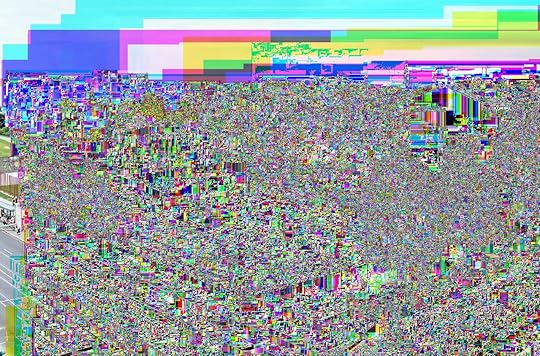
As mentioned, as well as these filter glitches, it's also possible to play around with the Compressed Data to produce images like the one below (notice the "snow noise" effect).

There are also more results to find when using transparent pixels in the process (the PNG format can handle transparent pixels without jagged edges, unlike other formats). The Adam7 algorithm can also be applied to PNGs to produce interlaced glitch effects. All of these methods are demonstrated by UCNV in his article. And due to all these possibilities, UCNV concludes that PNG is one of the best image formats to use for glitch art. "The filter algorithms are like toys," he says, just before showing off 120 different combinations of glitch effects.
Now, you may want to play with PNG glitches yourself after finding all this out. And yes, to make the PNGs easier to play with, UCNV has created the Ruby library called PNGlitch that allows for more efficient glitching. Unfortunately, you will need a basic understanding of the Ruby coding language to use it. So, er, get learning or find another way to produce glitches. I guess it's these types of barriers that separates amateur glitch artists from those who are a little more devoted to it, huh?
Read UCNV's full article on "The Art of PNG Glitch" right here.
Kill Screen Magazine's Blog
- Kill Screen Magazine's profile
- 4 followers



